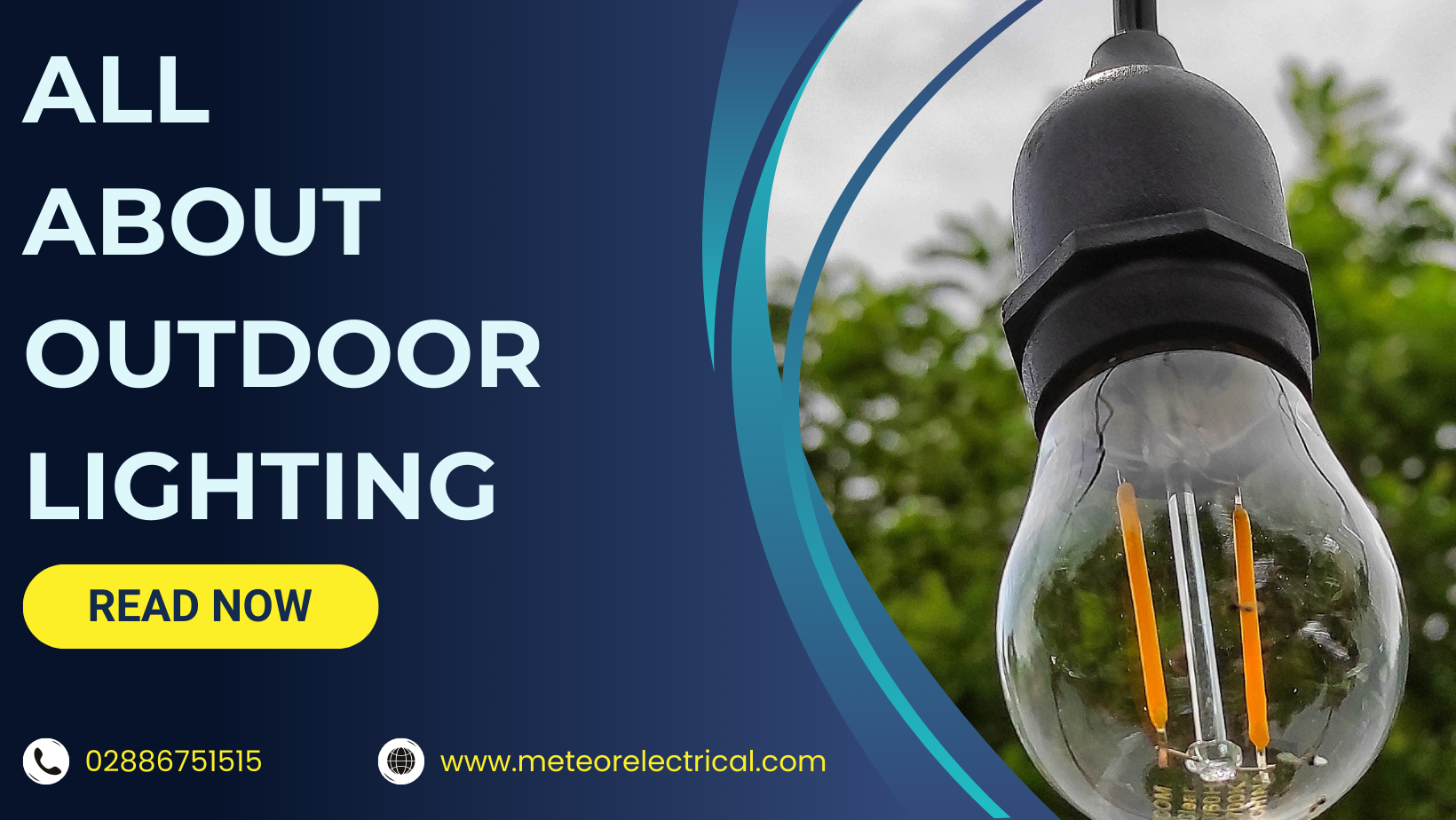Outdoor Lighting: Security And Ambiance
Many homeowners often spend a lot of time building their indoor lighting design, however, you must also pay special attention to your outdoor lighting. Outdoor lighting is a great way to elevate your landscaping and improve the outlook of your properties.
These luminaries are also important for ensuring the security of your home. If you want to learn more about this type of lighting, here is everything you need to know about outdoor lighting.
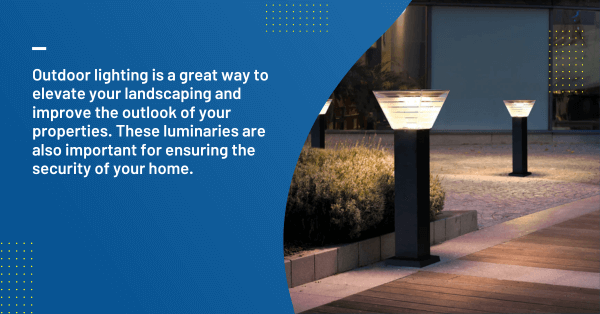
What Is Outdoor Lighting?
Outdoor lighting refers to luminaries that are specially designed for the exterior of a building or outdoor space. Since these lamps are exposed to outside elements both day and night, it is important to look for luminaries with resistance to outdoor hazards. These lamps are often weather-resistant or dustproof.
Some outdoor lighting, especially those designed with a motion sensor feature, can also help maintain security on your commercial property. However, there is so much more you can do with these luminaries.
For many people, creating an outdoor lighting design can seem complicated. While it is okay to install standard fixtures outside your building, it is crucial that you carefully plan and install outdoor light fixtures as this will do wonders for your building. It is essential that your outdoor area feels like an extension of your property.
You must carefully consider the design and aesthetic of the luminaries. Another important factor to consider is brightness. Exterior lighting should bring your outdoor space to life.
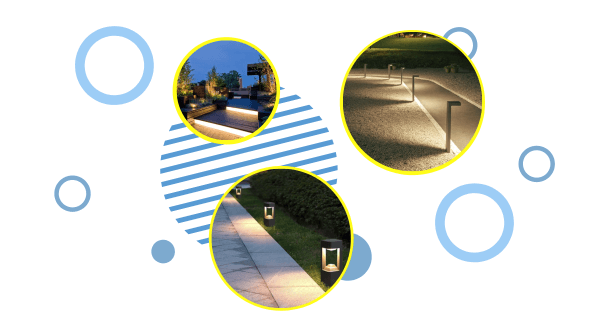
Whether you are using these lamps for security, landscape, or even just a dramatic effect, you must choose outdoor lighting that can transform the outlook or appearance of your building.
Additionally, you can use exterior lighting to create a path for people visiting your household. This type of lighting at night will make your home much more inviting to any visitors.
When designing the outdoor lighting space, it is crucial to understand how these luminaries will integrate with your building and the surrounding area. This will help create a seamless and aesthetically pleasing appearance.
However, you must remember that the goal of outdoor lighting is not to provide high levels of illumination. Instead, this type of lighting only illuminates enough to enhance the appearance of your building.
To create a pleasing lighting design, you must create a contrast between light and dark shades. Creating shadows outdoors can also help your lighting design and elevate your property’s appearance. The primary starting point when considering outdoor lighting is establishing the main design goal.
Creating An Outdoor Lighting Design
You must determine whether you are using outdoor lamps to highlight key features, focus on areas that normally don’t stand out or simply create clear pathways and entryways to your property.
During this process, you can also factor in any security concerns you want to address. With these qualities, you can see that outdoor lighting is incredibly versatile as it can be used for both ambient and security purposes.
You can use exterior luminaries to highlight a building’s architecture while creating a safe and secure environment. You can also layer different types of lighting to create the perfect light plan. Consider adding ambient, task, and directional lighting to achieve various illumination goals outside your property.
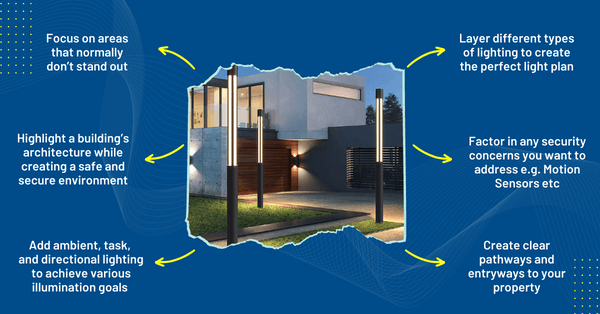
Once you have identified all the areas you wish to illuminate, you must consider the type of light product your want to use. Not all outdoor lighting is created that same, which is why you must consider carefully when selecting your perfect exterior light fixture.
Once you take all these factors into consideration, you will be able to create the perfect outdoor lighting for your home or commercial property.
What Are The Different Types Of Outdoor Lighting?
When it comes to choosing the perfect outdoor lighting, there are many fixtures to choose from. Each outdoor light fixture has its unique purpose that aids in creating a high-quality lighting design.
Here are a few of the most popular types of outdoor lighting fixtures.
Wall Lights
If you want understated outdoor lighting considers wall light fixtures. These luminaries are also often called lantern fixtures that provide subtle illumination on walls, doors, etc.
Wall lights are one of the most popular fixtures in household properties and they are used to illuminate entryways and verandas. However, you can also use them similarly in commercial properties as well.
One of the best ways to elevate a plain entryway is by adding highly decorative wall lights. These luminaries will make your home look more welcoming and inviting. Wall lights are mounted vertically onto the surface making them an ideal choice for textured walls.
Another reason why wall lights are so popular is due to their durability and aesthetic. These luminaries come in a wide variety of shapes, sizes and finishes to suit any property. Whether you have a traditional vintage-style home or a modern contemporary property, you can find wall lights that fit perfectly with your aesthetic.
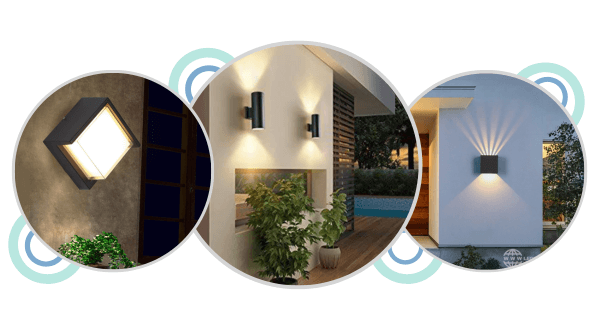
Since these lights don’t provide high-intensity illumination, they are often used as an accent or ambient lighting instead of general lighting. Wall lamps add a layer of depth to your building at night and also provide safety and security.
When it comes to lantern and wall light selection, the choices are endless. Different types of light fixtures can be used to highlight, accent, spotlight or create shadows and silhouettes. The lantern or wall light fixture you choose should reflect what you want the light to accomplish.
You can also choose between a variety of angles and fixture types such as uplights, and directional lights to create better outdoor lighting. Additionally, consider wattage or lumen output in mind when selecting these lamps because of your outdoor lights are too bright or clash with other fixtures, they may create a glare.
Decking Lights
For a more subtle approach to outdoor lighting, choose decking light fixtures. These luminaries are the perfect way to create ambient lighting in your outdoor space. You can use deck lights to illuminate pathways, and driveways to bring attention to any outdoor seating space.
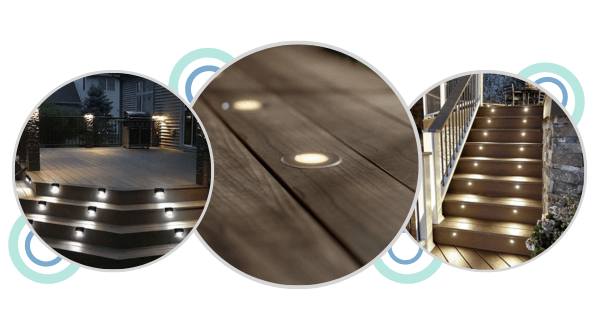
These lights come in a recessed shape that installs directly into paths or decking for a seamless finish that is safe to walk over. You can also add deck lights to your garden for decorative purposes. LED deck lights are a popular choice for many homeowners are they are highly energy efficient.
Spike Lights
Spike lights are a great option for those looking to create directional lighting outdoors. However, these luminaries are also versatile and can work well in garden settings as well. You can group several spike lights in an outdoor seating area for a cosy and welcoming environment.
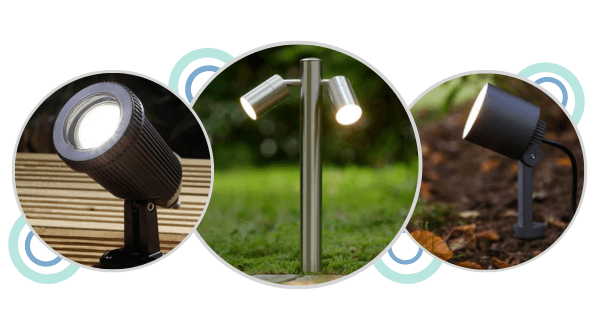
These lights are great for highlighting any design elements in an outdoor space. These include water features, a patio section and garden sections.
Another great benefit of spike lights is that they require no complicated installation. You simply place these lights into the ground and move them around according to your lighting needs.
Bollard Lights
Bollard lights are incredibly sturdy and durable making them an ideal choice for both household and commercial properties.
Bollards are often used to indicate pathways and entryways to buildings. These outdoor light fixtures often come in a round or square configuration and consumers can choose from several elegant finishes.
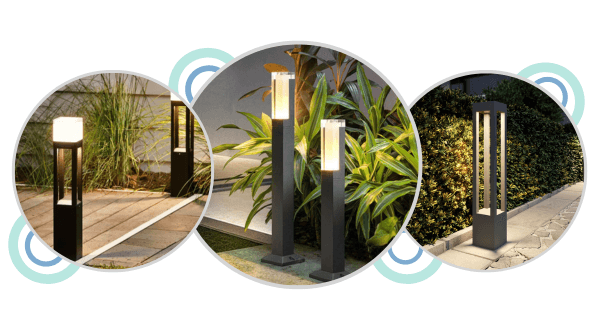
It is important to note that these lights do not provide large light beam angles as they are only two to four feet high. Most standard bollard lighting uses high intensity discharge bulbs such as metal halides however, these are outdated and highly inefficient.
To make the most out of your outdoor lighting, look for a bollard with LED bulbs. LED bollards use your energy efficiency without increasing your energy costs.
Dusk To Dawn Lighting
If you are worried about high energy consumption from outdoor lighting, consider installing dusk to dawn luminaries. These lights are extremely energy efficient as they only operate when the area around your building gets too dark.
Dusk to dawn lights is designed with special photo sensors which automatically trigger based on the sun rising and setting.
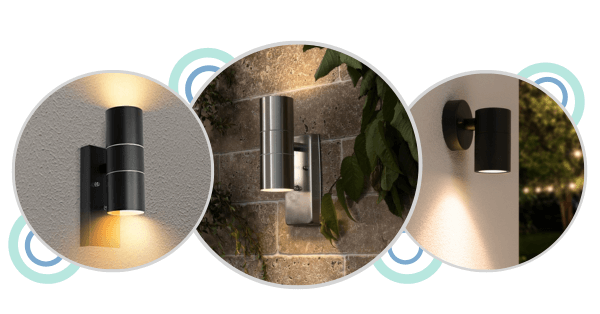
With LED dusk to dawn light fixtures, you can save even more on your energy bills as these luminaries last a long time. Dusk to dawn lights are a great way to ensure better control over outdoor lighting with hands-free functionality.
Security Lighting
As mentioned before, outdoor lighting can do so much more than just illuminate your space. These luminaries are a great way to add more security features to your property. Instead of large floodlights which can seem out of place on your property, you can find simple security lighting that is just as effective as larger security lamps.
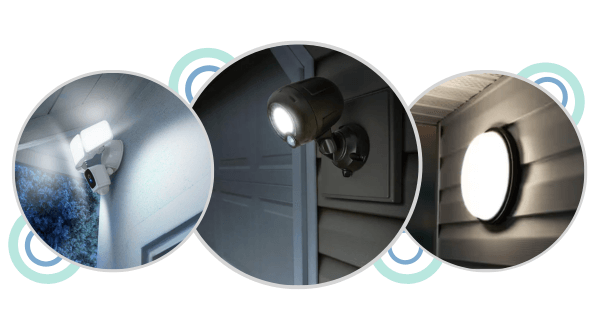
These lights are important for any property as they keep away intruders and make your outdoor space safer. Most security lights are designed with infrared sensors that automatically switch on when they detect movement around your property.
Make sure to choose a security light with a wide beam and affix it at least two meters from the ground. This will allow you to maximise your light ability and keep it safe from any damage and tampering.
Motion Sensor Lighting
For even more control over your outdoor lighting, consider installing motion sensor light fixtures. You can find motion sensor properties in most outdoor lights; however, there are luminaries that are specifically used for motion-sensing qualities.
These lights are ideal for security purposes as well as illumination of the busiest parts of your building, such as walkways and entry areas.
With a motion sensor, you can ensure that the light turns on only when it is needed. The angle and range of motion sensors vary by fixture design. In these luminaries, the motion sensor components illuminate fixtures when an object or person passes by the infrared beam. This movement allows the light to turn on for a specific period of time.
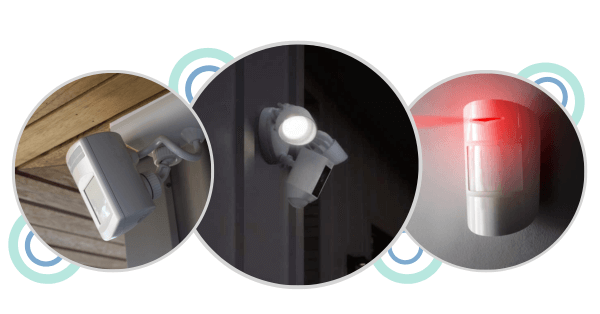
You can use this quality for security purposes as well. For example, motion sensor lights will automatically turn on if an intruder attempts to burglarise your property when it is unoccupied. The photocontrol or photocell in the motion sensor lights acts as a timer that can be set to your preferences.
The built-in timer on most motion sensor fixtures is adjustable, so you can have better control over your illumination. Sometimes these lights also work just like dusk to dawn fixtures to adjust your lighting levels according to the time of the day.
Microwave Motion Sensor Vs. PIR
When it comes to motion sensor outdoor lighting, there are several types of sensor components to choose from. Some of the most popular choices for motion sensor LEDs use a microwave or PIR component.
Light fixtures with a microwave motion sensor have better functionality than ordinary lamps. The microwave motion sensor makes lighting more efficient by adding better controls. With this feature, you never have to operate your lighting manually. This feature is great if you are installing outdoor lights in areas that are hard to reach.
Microwave sensors can work well in almost any environment, even in areas that are not well suited for other sensors. These include high-heat areas that can easily set off photo sensors. This quality makes them one of the most versatile sensor systems on the market.
This feature can detect through walls and other tough areas as they cast a wide detection beam compared to other sensor systems. Due to this quality, you should use microwave motion sensor lights for larger household properties or commercial areas.
If you want efficient lighting to cover large grounds, a microwave motion sensor is your best choice. Most microwave sensors allow you to program away any false alarms. Some sensors get triggered through false detection, which can significantly lower your light efficiency.
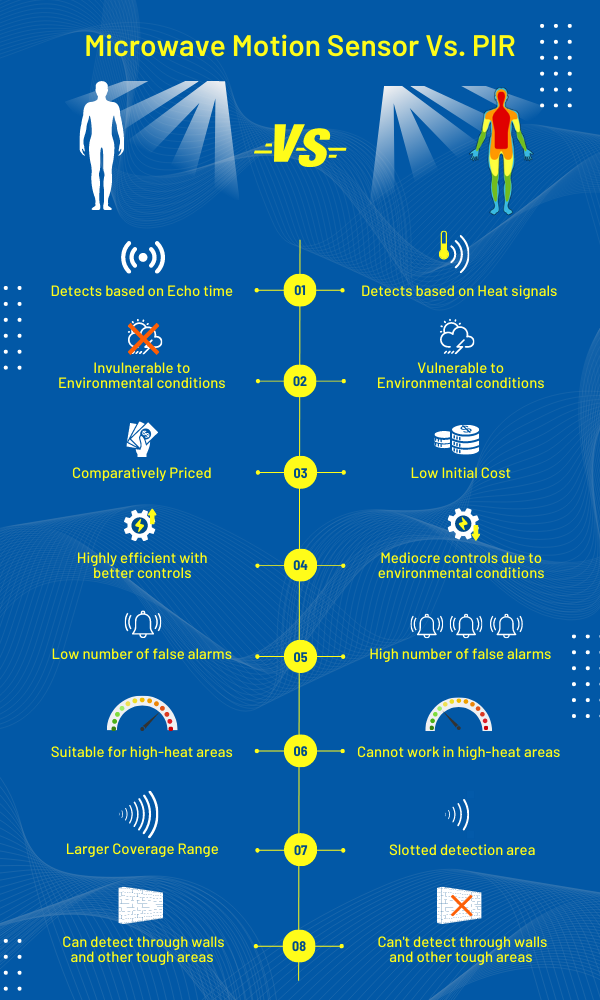
With a microwave sensor, you can easily reduce false alarms without reducing the number of correct positives. This feature allows you to improve your sensor’s accuracy and ease of functionality.
Microwave sensors are one of the most reliable systems on the market, and they are very easy to use. These sensors are simpler than any other motion sensor on the market, making them the ideal choice for first-time users.
On the other hand, PIR sensors are designed to detect heat signals, and they do this by calculating the ambient temperature of the area. This temperature is measured through the sensor’s detection beams.
When the PIR detects a temperature difference, the sensor becomes activated and switches the lighting on. When the detection beams sense the threshold temperature again, the lights switch off.
Out of these two sensors, the microwave is the best option as it provides consistent quality throughout its operation. PIR sensors are highly sensitive to temperature levels, so they are not versatile for many applications.
These sensors also tend to give more false alarms making them less efficient than microwave sensors. Microwave sensors have a larger coverage range than PIR sensors, and they provide a continuous field of detection.
In comparison, PIR sensors have a slotted detection area which means they miss out on certain objects. Since microwave sensors improve efficiency, it is important to choose this component for your motion sensor outdoor lighting.
What To Consider When Choosing Outdoor Light Fixtures?
Since there are a wide variety of outdoor lights to choose from, you need to know which one is best for you.
Each luminaire works well in outdoor settings but they carry out varying functions. Here are some important factors to consider when choosing your ideal outdoor lighting fixture.
Choose LED Lighting For Your Outdoor Space
When choosing the perfect outdoor lighting, it is important that you consider energy efficient lighting. Energy efficient lights reduce the energy usage of the light model without affecting the final lumen output or brightness.
An energy efficient light fixture consumes less energy to perform the same function as a standard light. These qualities are at the core of energy efficient lighting. It is important to understand that energy consumption does not correlate to the quality of brightness.
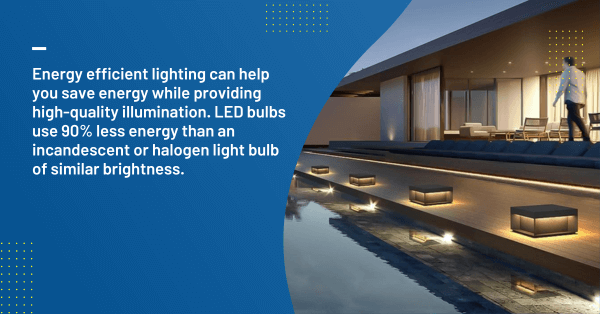
Energy efficient lighting can help you save energy while providing high-quality illumination. LED bulbs use 90% less energy than an incandescent or halogen light bulb of similar brightness.
The structural component of LEDs makes a key difference in this conversion because, in other light models, most of the energy would get wasted as a heat emission. However, LED lights do not produce heat; therefore, they make much better use of the energy consumed.
Another great benefit of using LED light bulbs is the longer lifespan. Since there is no thermal emission, the LED bulb does not suffer any damage and therefore does not need constant replacements. A well-built LED light bulb can last 25 times longer than any other light bulb.
Choose The Correct Wattage
Another important aspect to consider is the wattage of your outdoor light as it involves the function of your fixture.
If you have a large space, you might not look for lights with a higher wattage to produce appropriate brightness. However, for outdoor lighting, you often don’t need high levels of brightness. If you want lights for ambient or decorative purposes, low-wattage luminaries would work well.
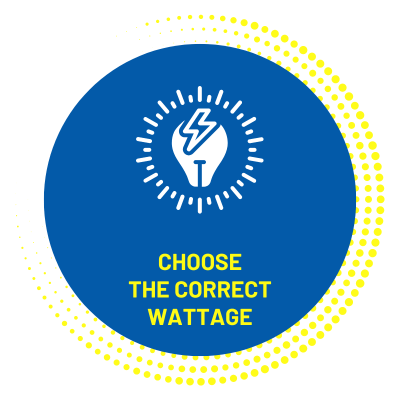
If you are opting for LED outdoor lights, you must look at the lumen output instead of the wattage. Since these luminaries do not use a lot of energy, the lumen value is the best indication of their brightness level.
The Budget And Cost
For most homeowners looking to improve their property, it is important to create and stick to a budget.If you want to add outdoor lighting to your property, it is important to think of the costs before making a purchase.
There are a wide variety of options ranging from various price points; therefore, it is important to have a lighting budget in place. In terms of the costs, you should also think about how many lights you need.

Do you plan on illuminating the entire perimeter of your building, or do you only want to focus on the front door section where most people enter your home? These points will help you decide the amount of lighting you need. Having a budget ensures you will only buy the right lighting fixtures for your home.
The Durability Of The Fixtures
Durability is an important factor to consider when purchasing outdoor lighting. Since these light fixtures are exposed to several hazardous elements, it is important that you invest in light sources that can withstand multiple harmful particles.
Almost all high-quality outdoor lighting has an IP rating that determines its durability. To choose the best IP rating for your lighting, you must assess the outdoor conditions of your area. If the area your building is located in experiences frequent rain, you should opt for outdoor lighting that protects against moisture.
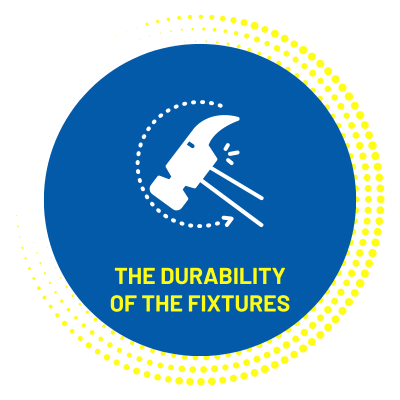
If there is heavy wind and dust in your area, consider outdoor luminaries resistant to dust and solid particles. Additionally, LEDs can provide even more durability to your outdoor lamps. LEDs are highly efficient and do not burn out as quickly as other standard bulbs. With LED outdoor lighting, you don’t have to worry about frequent maintenance costs.
Consider The Colour Temperature
The colour temperature of your light also affects the appearance of your property. With LED lights you can choose through a wide range of colour options to choose the best one for you.
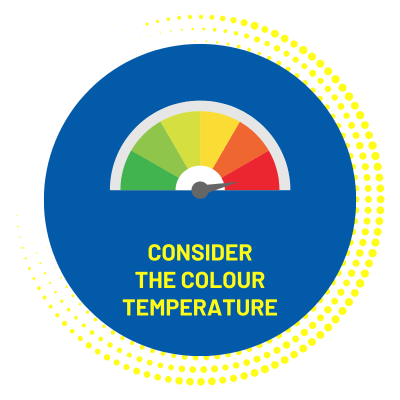
For lighting, you need to look at the Kelvin scale to find the best shade possible. This scale ranges from cool to warm lighting. The lower the temperature, the warmer the light will appear. If the Kelvin number is high, the light will have a cool white shade.
Consider The Lighting Placement
Another important factor to consider includes light placement. Strategic outdoor lighting placement adds depth to your building. Not all light fixtures work well in every location.
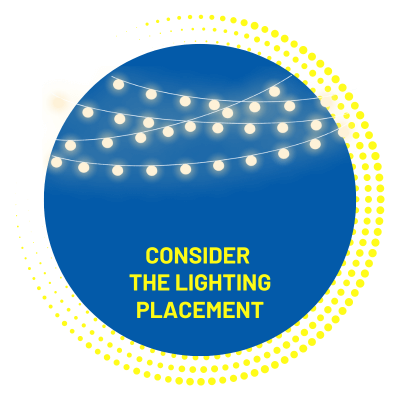
For example, wall lights might work well for the entrance of your building, but they might not provide sufficient lighting for other sections of the property. Therefore, it is important to plan where you want your lights to be before you make a purchase.
If you want to highlight the area surrounding your property, you should invest in lamppost lighting. If you want directional lighting for pathways, consider bollards or ground lighting. Making a list of all the areas you want to illuminate will help you make informed purchases.
Consider The Aesthetic Of Your Fixtures
Your outdoor light fixtures should be uniform in terms of illumination and appearance. Make sure to purchase light fixtures with a similar look and finish for a consistent design aesthetic. You can choose to install all lighting fixtures in a chrome colour, or maybe you want minimalist luminaries.
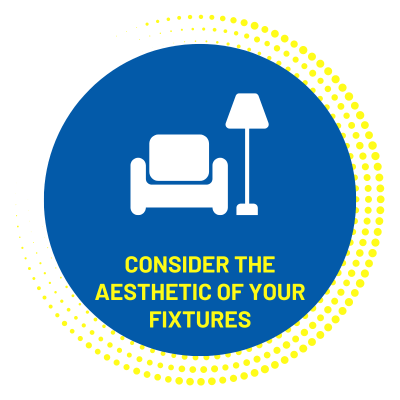
You can maintain a similar design as your interior lighting by choosing a similar finish. Once you have your preferred design category, make sure to install lighting that fits this theme for a visually appealing look.
Why LED Outdoor Lights Perform Better Than Any Other Lights?
As mentioned before, LED outdoor lights are a crucial addition to any lighting design. These luminaries perform much better than any other light on the market due to their energy efficient qualities.
When it comes to outdoor lighting, LEDs aren’t the only choice. Many residential and commercial properties are equipped with metal halide outdoor lighting; however, these are highly inefficient.
If your property still uses metal halide lamps for outdoor lighting purposes, here is why you should switch to LED outdoor lighting. Even though they have a larger size, metal halide lamps are highly inefficient when compared to LED outdoor lighting.
While most metal halide lamps provide a reliable light output, they have a weak staying power. LED lamps use fewer watts to create lumen output. In terms of lumen output comparison, LED lamps perform much better. These two lamps offer completely different technologies as methods of producing light.
Metal halide lamps contain a combination of metals, including mercury, that is evaporated into an inert gas. This gas is contained in the glass casing of the metal halide structure.
In comparison, LEDs contain a solid-state semiconductor component. While both technologies produce high-quality lights, LEDs use energy more efficiently and last a lot longer. LEDs also require less intensive maintenance over prolonged use.
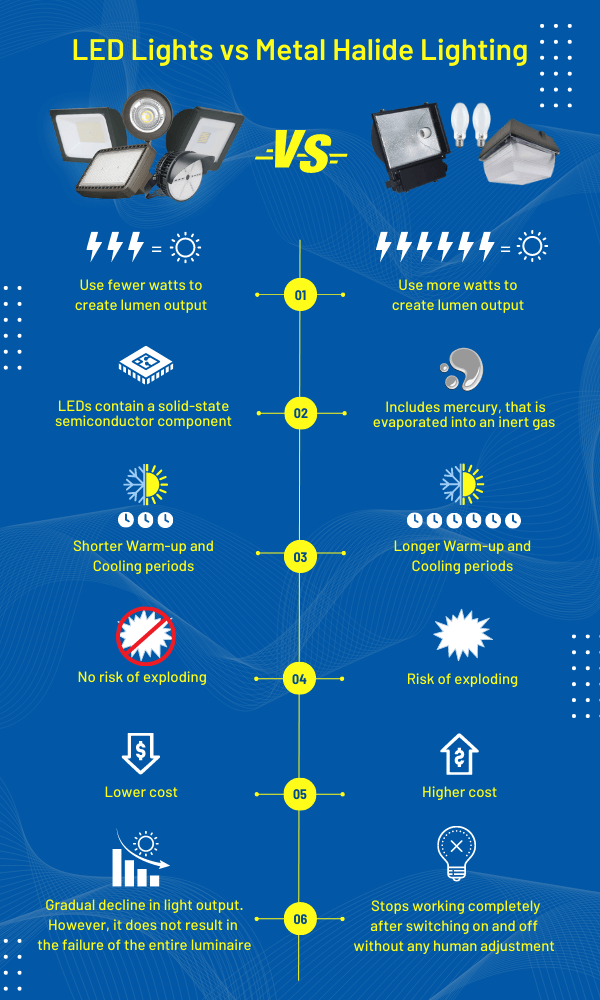
As mentioned earlier, metal halide lamps have a longer warm-up period compared to LEDs. Some lamps can take 15 minutes to turn on completely, and you also need to give these lamps a cool-down period before turning them back on again.
Additionally, some metal halide lamps carry a small risk of exploding. Even though some metal halide lamps cost about the same as LED lamps, the halide luminaires keep adding expenses over time based on their inefficient operation.
In large-scale applications such as commercial outdoor lighting, these costs will add up significantly. To make the best comparison between LED and metal halide outdoor lighting, it is important to look at their failure components.
Recognising the failure components in lighting is important as it helps you decide which lamps are worth investing in.
LEDs' most significant failure component is their gradual decline in light output. However, LED lamps usually operate with multiple light emissions in a single lamp, which means the loss of two emissions does not result in the failure of the entire luminaire.
On the other hand, metal halide lamps experience a phenomenon called cycling. This is when the lamps switch on and off without any human adjustment. Shortly after this, the lamps stop working completely.
For this reason, metal halide lamps can be highly inconvenient compared to LEDs. With these qualities in mind, it is clear that LED lighting is far superior to other forms of luminaries. Therefore, it is important to implement outdoor LED lighting to enjoy multiple energy saving benefits in the long run.
What Are IP-Rated Outdoor Lights?
One of the most important factors to consider before purchasing an outdoor light is the IP rating. Since outdoor lighting is exposed to several weather elements, it is important to install rated light fixtures as these will last longer.
Outdoor light fixtures without an IP rating are prone to damage resulting in higher replacement and operating costs. When choosing your IP rated lights, look for luminaries that are waterproof and dustproof.
These are two of the most common hazards many outdoor lights face; therefore, it is important to purchase lighting that offers protection against these elements.
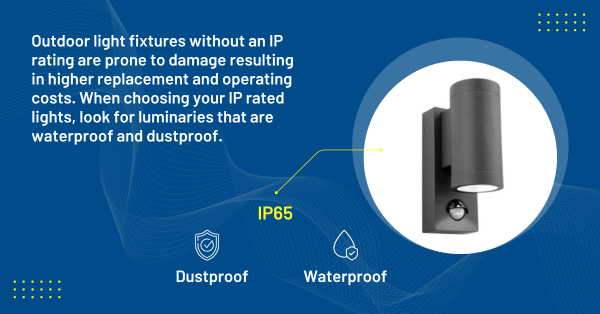
Even if your lights are not directly in contact with water and dust, these particles can settle into any nook and cranny, so make sure only to get high-quality to avoid this problem.
Manufacturers who create high-quality light fixtures make sure to comply with safety laws and regulations to ensure the best products. These light products are created with sealed electrical components to prevent any element from harming them.
One of the most important laws that maintain that safety of electrical products is the Ingress Protection or IP ratings. These levels were set as a universal measure determining the safety of light fittings and their interaction with outdoor elements.
IP ratings use several levels to determine the safety of light products. For example, some IP-rated lights can be submerged in water and still be safe for operation. While others are only safe to be rained on.
To get a better understanding of how IP rating works, you must look at the value given to the light product. The first number of the IP rating refers to the level of protection the light has against solid particles. Here is how this rating works:
- 0: No special protection offered
- 1: Protection against items than 50mm in diameter.
- 2: Protection against fingers and no objects larger than 80mm in length and 12mm in diameter.
- 3: Protection from tools, wires, etc., having a diameter larger than 2.5mm or more.
- 4: protection against solid elements larger than 1mm, including small tools.
- 5: Protection against any dust particles that may harm the electrical components.
- 6: completely dustproof.
The second number of an IP rating refers to its protection against liquid particles and moisture. This is what these values stand for:
- 0: No protection offered
- 1; Protection against vertical water droplets and condensation
- 2: Protection against vertical water droplets at 15 degrees.
- 3: Protection against water spray up to 60 degrees vertically
- 4: Protection against water spray in any direction
- 5: Protection against low-pressure water jets from any direction.
- 6: Protection against water waves and jet sprays
- 7: Protection against temporary water immersion.
- 8: Protection against long-term effects of immersion in water pressure.
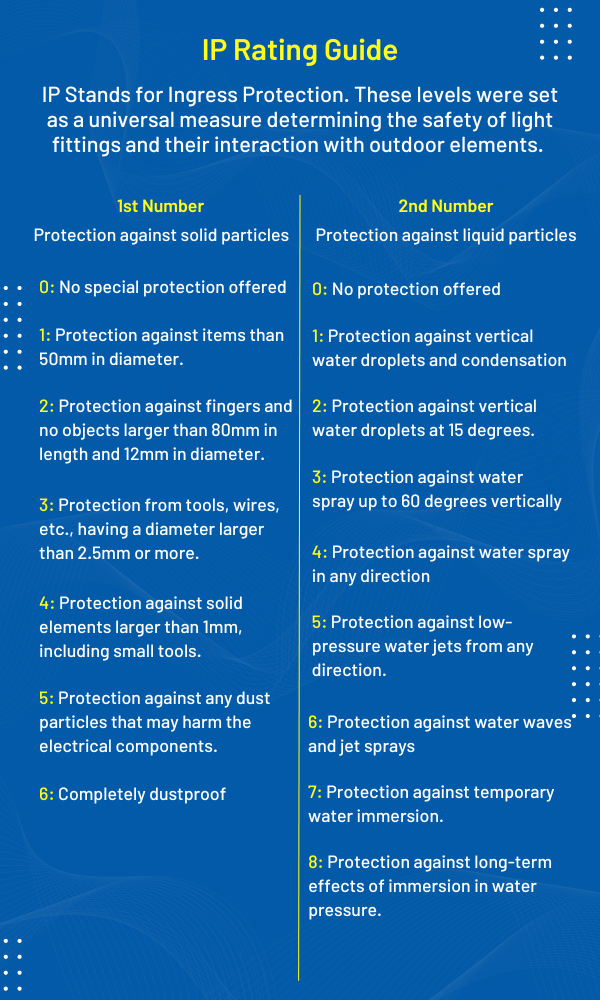
With these IP ratings in mind, you can purchase the ideal outdoor lighting for your commercial building. For example, a light fixture with an IP rating of 68 will be protected from both solid object intrusion and moisture.
This type of light fixture will work well for household and commercial properties close to a water feature. Make sure to assess your surrounding before choosing the best IP rating for your outdoor light fixtures.
What Are The Benefits Of Outdoor Lighting?
If you are still trying to decide whether to invest in specialised outdoor lighting, here are some reasons why you should install exterior light fixtures.
Improve Aesthetics
A great way to make your home look more inviting is by improving its light design. A good outdoor lighting design will elevate the appearance of your home. If your home has a simple appearance from the outside, you can elevate your aesthetic with a carefully planned lighting system.
With outdoor lighting, you will not need any expensive decor elements and landscaping to create an aesthetically-pleasing environment. Outdoor lighting can be used to highlight any design features, illuminate entryways and elevate the welcoming aspect of your property.
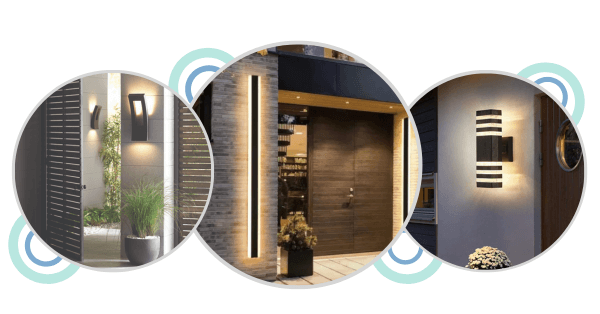
When you plan your outdoor lighting, consider any important features you wish to highlight. Whether you have any architectural details on your patio or beautiful trees and flower beds, you can add specific lighting to highlight these areas and elevate your aesthetic.
If you have any water features, you can install underwater LED lighting to add more depth and bring attention to it. Regardless of how you design your outdoor lighting, these luminaries will do a great job of elevating your home’s aesthetic.
Improve Safety And Security
Whether you are a homeowner or a business owner, it is important that you protect every part of your property. Outdoor light fixtures are one of the best ways to ensure the safety and security of your building.
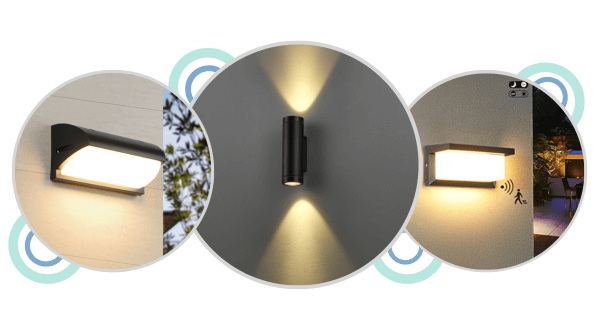
Without any dark shadows or zones, intruders will feel less confident to attempt to burglarise your building and vandalise any section of it. With outdoor lights, you can reduce the amount of crime that occurs on your property and protect your property investments.
Increase Property Value
Installing the right outdoor luminaries will improve your property’s value significantly. The lights will highlight the most beautiful aspects of your home or commercial property making it appealing to anyone that looks at it.
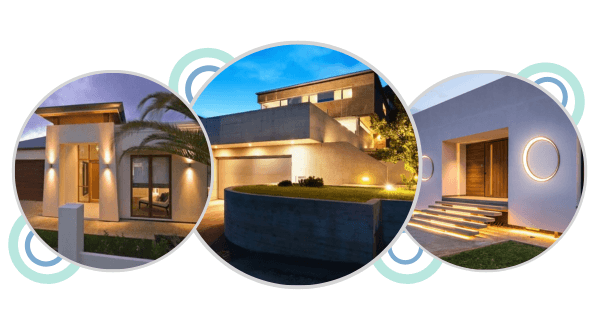
Importance Tips For Creating An Outdoor Lighting Design
If you want to design an efficient and high-quality outdoor lighting design, here are some important tips to help you along with the process.
The Lighting Should Compliment Your Home
Since these luminaries affect the outward appearance of your home, consider lighting that compliments your property. If your home has a modern aesthetic, stick to lamps that match this style. You can also use similar or complementary colours to create a cohesive design.
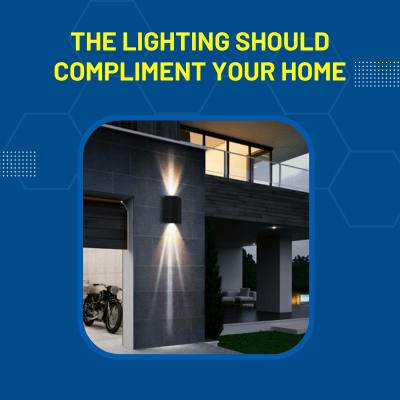
For traditional homes, choose vintage outdoor light fixtures to elevate your home’s appearance. This step works well for highly visible light fixtures. If there is outdoor lighting inground, you don’t have to consider its design too much.
Consider Your Landscaping
Apart from your building structure, the outdoor lighting should also complement your landscaping. When planning your lighting design, make a note of any important areas you wish to highlight.

Consider illuminating beautiful sections of your garden as you don’t want to end up with lights that clash with your landscaping. By highlighting these sections, you will improve your home’s exterior appearance even more.
Make Sure To Space Out The Lighting
Planning your outdoor lighting design is essential as it allows you to evenly space out your luminaries. Some fixtures have a bright illumination making them ideal for bigger spaces. This means you can add fewer fixtures to get your desired lighting effect.
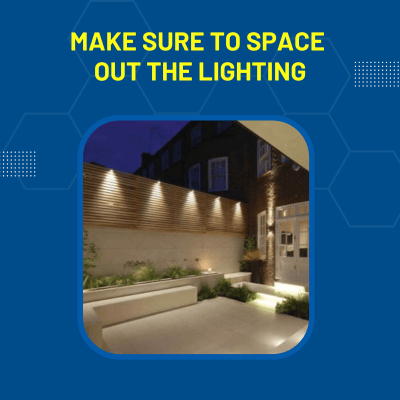
Too many luminaries will create a harsh glare that will become an eyesore. Therefore, carefully space out your lighting according to its illumination or lumen output to create a seamless design.
Final Takeaway
Outdoor lighting is just as crucial as indoor lighting. These luminaries not only improve the aesthetic of your property but also provide safety and security.
A well-planned lighting design will benefit your property greatly. For some of the best lighting, choose LED outdoor luminaries as they are energy efficient and have a long lifespan.

